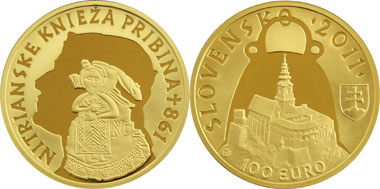January 12, 2012 – Pribina was the first renowned Slav ruler. Born in around AD 800, he was the Prince of Nitrava, a territory in the Western part of present-day Slovakia, where he reigned until 833. His fortress was surrounded by a river at the site of the present-day city of Nitra. Pribina has a permanent place in Slovak history and his legacy has over the centuries influenced the cultural awareness of the Slovaks.
Slovakia – 100 Euro – 900 gold – 9.5 g – 26.00 mm – design: Ivan Rehák – Mintage: 7,000.
The observe side of the coins features a silhouetted outline of the Bojná bell and a centrally placed depiction of Nitra castle in its current form. On the left side of the design is the country name SLOVENSKO, and on the right side the year 2011, below which is the national emblem of the Slovak Republic. The denomination 100 EURO is written in the lower part of the field. To the left of the denomination is the mark of the Kremnica Mint and to the right are the stylized initials of the coin‘s designer, Ivan Rehák.
On the reverse side there is an imagined portrait of Prince Pribina. The center of the design depicts a fragment of the plaque found at Bojná. Near the edge of the coin is the inscription NITRIANSKE KNIEZA PRIBINA (Prince Pribina of Nitra) and the year of his death 861.
The first record of Christianity in the territory of Slovakia is associated with the name and acts of Pribina. Although a pagan, Pribina had a Christian church built at Nitra, which was consecrated by Archbishop Adalram of Salzburg in 828. The church served Pribina’s Christian wife, who was probably a member of the noble Bavarian Wilhelminer family. His son Kocel’ was born in Nitra, and Pribina, in line with his wife’s wishes, gave him a Bavarian name and had him immediately baptized. A contemporary record of the building of the church and its consecration by the archbishop not only provides evidence of the penetration of Christianity in Slovakia, it also contains the first recorded mention of a settlement in the territory. The arrival of this new religion, supported by the ruling classes, led to major changes in the life of what had up to then been a pagan society.
Pribina’s reign saw the emergence of many settlements which, with the later establishment of castles and towns, played a significant role throughout the Middle Ages. The economic and administrative center of the principality was located at Nitra, and another important settlement was Bojná (in the present-day district of Topolcany).
Pribina ruled Nitrava for only five or six years. In 833, he was driven out of his homeland by the Moravian ruler Mojmir, against whom he had been fighting since 830. The principalities of Moravia and Nitrava were thus unified to become the Great Moravian Empire, which until the beginning of the 10th century was the most powerful empire in central Europe. After his expulsion from Nitra, Pribina sought sanctuary with Prefect Ratbod, and then with Presian, the Khan of Bulgaria. After failing to secure help from either the Franks or the Bulgarians, Pribina returned to the court of Ratbod, who presented him to Louis the German, the King of East Frankia. The King ordered that Pribina be baptized in Salzburg’s church of Traismauer and in around 840 made him the suzerain of lands in the duchy of Carinthia, specifically the territory around Zala in Lower Pannonia (Hungary). Within ten years, the King made Pribina the hereditary duke of this area, with his ducal seat at Zalavár on the southwestern tip of Lake Balaton. Here, too, Pribina was active in spreading Christianity and commissioned the construction of at least 16 churches. Pribina died in 861 during a battle against the Moravians.
Most of what we know about Pribina is contained in „Conversio Bagoariorum et Carantanorum“ (The Conversion of the Bavarians and the Caratanians), a history of unknown authorship written in Salzburg in 871. Among the other sources of information about the rise and fall of Pribina’s Principality at Nitra are archaeological findings discovered in the area of Bojná, along with artefacts indicating the stratification of society in the Principality and the Great Moravian Empire. Other finds include opulent jewellery, clothing bedecked with gold and silver, decorative horse-riding equipment and weapons. The site was also made famous by the discovery of artefacts from the oldest Christian mission of the Pribina period. The reverse side of the coin features a bell that is one of the oldest in Europe, and the obverse depicts a plaque bearing the first recorded writing in Slovak history, the Latin abbreviation IN DE, short for CREDO IN DEO (the plaque came from a portable altar and also depicts a gilded angel).
For more information on the coin, please visit the site of the Central Bank of the Slovak Republic.





